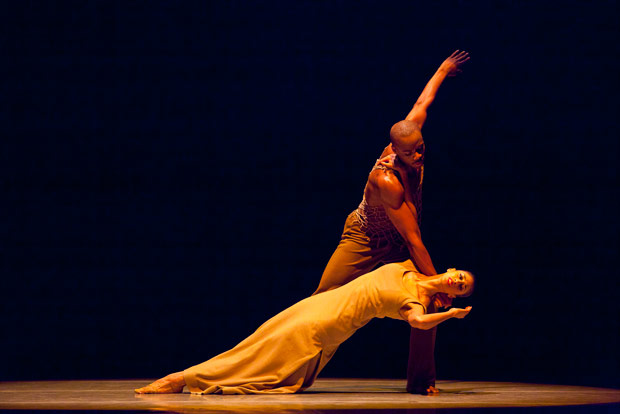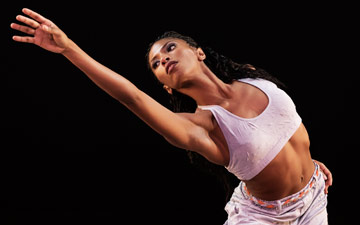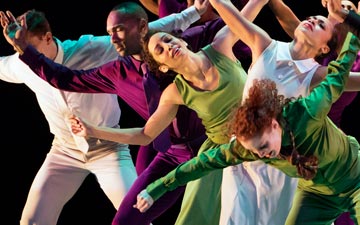
© Gert Krautbauer. (Click image for larger version)
Alvin Ailey American Dance Theater
Polish Pieces, Awassa Astrige, The Pleasure of the Lesson, Revelations
New York, City Center
7 Dec (mat) 2014
www.alvinailey.org
www.nycitycenter.org
Timelessness is a key factor in any great work of art. Although juxtaposed with several new and recently revived productions, Alvin Ailey’s Revelations looks just as good now as it did 10, 15, or even 20 years ago, and probably looks just as good as it did at its premiere, way back in 1960.
The dancers of Alvin Ailey American Dance Theater can perform Revelations in their sleep. It is a testament to the current troupe, to artistic director Robert Battle and to Ailey himself that the work continues to look fresh in 2014. Set to rousing gospel spirituals, Revelations is a guaranteed standing ovation. People cry, clap and sing along. And why not? Is there anything more exhilarating than the vignette for Sinner Man, in which three hot-blooded men tear across the stage in a dazzling display of vigor? Featuring in the second solo, Kanji Segawa whipped up a frenzy with his spinning-top turns and far-reaching leaps that defied his petite frame. In Wade in the Water, Demetia Hopkins Greene’s smile was equal parts sunny glow and mischief, exuding the confidence of a company veteran (she joined in 2010). The fusion of soul and modernism is at its peak in the pensive pas de deux Fix Me, Jesus, eloquently portrayed at the Sunday matinee by Ghrai DeVore and Marcus Jarrell Willis.

© Paul Kolnik. (Click image for larger version)
And that’s the thing: Ailey was elegant. The opening image – a triangle of dancers with their chins up, bathed in golden light – firmly and immediately plants the work in the realm of devotion. The dancers’ open palms reach skyward, then swoop and turn into birds’ wings. Fix Me, Jesus has moments of exquisite architectural crispness. Most of all, Revelations feels whole, complete and knows itself. Not too long and not too short, Revelations successfully personifies a spectrum of moods (mournful, joyful, contemplative, passionate) without feeling schizophrenic. Dance regulars may yawn at Revelations‘ continued programming presence, but it’s a great litmus test for the current state of the troupe, and also just plain fun. The jaded ones are missing out.

© Paul Kolnik. (Click image for larger version)
Robert Moses’ The Pleasure of the Lesson, which made its world premiere with Ailey at the Koch this summer, is more mysterious. Set under moody, blood orange lighting, Pleasure has a vaguely tribal air about it, and the problem is with its very vagueness. Women wear halter tops with loin tunic skorts and the men are shirtless with loose pants. The opposite sexes line up across from each other, the women crossing their arms and stomping rhythmically. There is an approach and a retreat, and the motif dissolves. A woman is lifted into an awkward, table-like position, as if part of a ritual, and is promptly dropped, just like the mood. The segues between different ensemble groupings meander. The patterns that surface don’t recur enough to give significant meaning or cohesion. The jittery, restless work suffers from an identity crisis. It’s a shame because a lot of the choreography is difficult, but the work ends with a redeeming, steamy pas de deux, which on Sunday starred the lean and lithe Jacqueline Green partnered by a lusty Antonio Doutit-Boyd. With cheekbones that give Tilda Swinton a run for her money, Green is stoic in Moses’ hands, and an emblem of pure power. With the flick of a finger her partner is flat on his back, stunned but ravenous. The sexual component is obvious, but is she expressing empowerment? Vengeance? The purpose is a mystery, but Green’s conviction – which carries to the back of the house – is concrete.

© Paul Kolnik. (Click image for larger version)
Anyone who has seen ostriches up close knows they’re not the most graceful creatures, but they get a dreamy romanticization in Awassa Astridge/Ostrich by Asadata Dafora. First presented in 1932, the solo is a signature work by Dafora, a trailblazer who was one of the first importers of authentic African music and dance to the United States. Wearing nothing but a multi-colored plumage skirt, Douthit-Boyd stalks the stage to a score of gentle percussion and evocative winds. He checks out the space, snaps his head, and plunges into pronounced, full-frontal plies. Reminiscent of a mating ritual, when the undulations reach the hips, it is virility pure and simple. At less than five minutes long (possibly less than four), Awassa Astridge/Ostrich is a striking miniature of a work.

© Andrew Eccles. (Click image for larger version)
Hans van Manen’s Polish Pieces entered the Ailey repertoire back in 1996, a year after its creation, and has been revived this year. Set to a haunting minimalist score by Henryk-Mikolaj Gorecki, the first section sounds like the build-up to a terrifying scene in a horror film. Anyone looking for hints at Wayne McGregor’s influences (Forsythe aside), especially the arched back and protruding posterior, need look no further. But van Manen’s extremes aren’t as exaggerated. Two highly sexual pas de deux – performed by Jacqueline Green, Yannick LeBrun, Sarah Daley and Jermaine Terry – weight the piece. Abstract dance can often be performed with a certain ghostly blankness, but on these dancers van Manen carries well. Without slathering on the melodrama or forcing any particular narrative, the sensuality has real gravity, purpose and ownership – the tension as believable as it is beautiful.

















You must be logged in to post a comment.